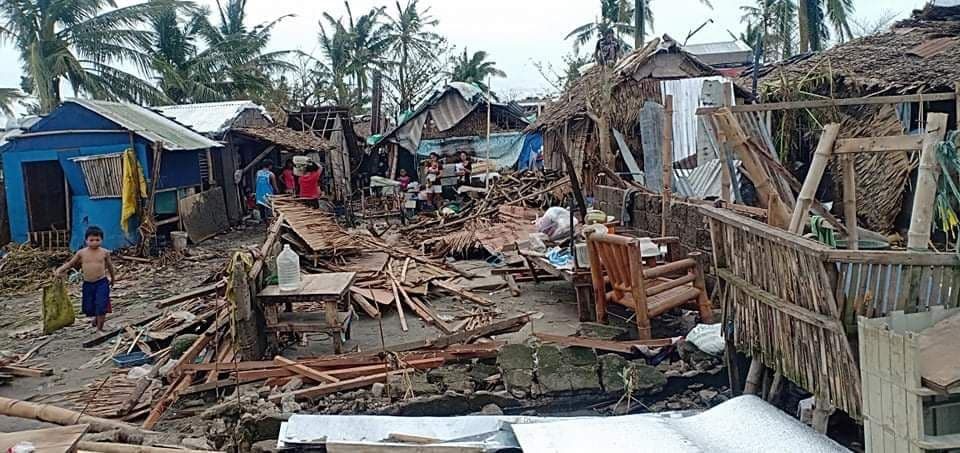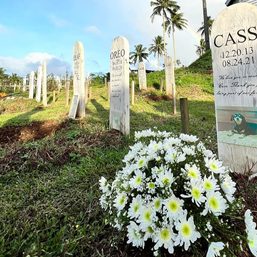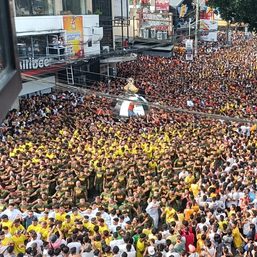SUMMARY
This is AI generated summarization, which may have errors. For context, always refer to the full article.

Residents of Barangay Sabang in Calabanga town, Camarines Sur, suffered destructive consecutive typhoons in 2020. After Typhoon Quinta (Molave) and Super Typhoon Rolly (Goni), along came Typhoon Ulysses (Vamco) which pummeled whatever was left of their homes.
With Christmas nearing, they find themselves falling deeper into despair as they have no one to turn to. May Azañes is one of them.
Azanes, who lives with her husband and child, makes a living as an ukay-ukay vendor while her husband works at construction sites.
Their village is no stranger to typhoons and often escapes the brunt of it when storms come. After Quinta passed, she never thought that the following typhoons would take her home.
Faced with the unexpected
On October 31, the day before Rolly hit Camarines Sur, the Philippine Atmospheric, Geophysical, and Astronomical Services Administration (PAGASA) raised the storm signal in the province to Signal No. 5. It was a sunny day, but the residents knew that the blue sky was deceiving.
They prepared the same way they always did: reinforced their roofs, wrapped their belongings in plastic, and strengthened the frames of their houses.
In the early hours of Sunday morning, Azañes said, the weather was still calm so her fellow villagers still went about their day. It was at 6 am in the morning when the winds started howling and the heavy rains fell. In the span of a few hours, the barangay felt the storm surge and sea water reaching their houses.
Azañes evacuated early on with her family and stayed with a relative that was far from the coastline.
She said she saw Facebook posts from her neighbors and other relatives that the flood water levels were already the same height as their houses. People were stuck on boats trying to get to higher ground to escape the floods while the winds battered them.
Azanes said they were even lucky that the typhoon hit in the morning, or else, more lives would have been lost that day.
No one anticipated the kind of destruction that Rolly would bring. Their seawall kept them safe from past storms but Rolly broke the structure, Azanes learned later.
Rolly takes all
Sabang is a fishing coastal village. The only time that floodwaters ever reached the same level as Rolly was in the 1970s, according to the elders that Azañes had spoken to.
At noon on November 1, the weather permitted them to check on their village. It was clear as day that everything was in shambles.
As Azañes and her husband walked 10 kilometers to get to their house, they saw images that she would recur in the coming weeks: Floodwater reaching the hips, uprooted narra and acacia trees that blocked roads, and sunken houses.
“Kaya malayo pa kami alam ko nang wala na kaming mauuwiang mag-asawa na bahay. Pagkakita ko, wala na, umiyak na lang kaming mag-asawa,” she said. (Even if we were still far away, we already knew we had nothing to return home to. When I saw there was nothing left, we just cried.)
She was traumatized and didn’t know how to start all over again.
“Kasi ang hirap sa amin, hindi kagaya ng ibang mga lugar, sa amin talaga na wala, pagkatapos ng tubig wala na, nadala ‘yung mga gamit namin pati ‘yung bahay namin nawala talaga,” she said.
(It’s difficult in our case, because unlike in other places, once the waters recede, everything is swept away with it, including possessions and our house.)
Ulysses drowns hope

Immediate relief came to the barangay when Vice President Leni Robredo visited Camarines Sur on November 2.
Azanes and other villagers received relief goods and construction materials to rebuild their houses totally damaged by Rolly.
The very next week, however, on November 11, another typhoon hit the barangay just as residents were beginning to hope that they could get their lives back on track.
With a broken seawall, all reconstruction efforts started the past week were wiped out. The climate made it impossible to distribute relief goods throughout the region. And all the residents had to flee for their lives again.
Azañes said that before Ulysses hit, some of the residents were staying in the barangay hall where they had some basic necessities available as well as electricity.
Other residents had stayed in the evacuation center, but even then the windows there shattered by the winds. People had to move to another evacuation center in the middle of the onslaught.
In the aftermath of Ulysses, all the unfinished houses that they were trying to rebuild were destroyed yet again, the frames and raw materials swept by the raging waters.
When Azañes went around her village all she could see was devastation: washed-out shelters, uprooted trees, and fallen down posts. All her neighbors were crying in the streets. Like them, she too wondered how to start over again.
Rising from nothing
Azañes said all the villagers were in despair as they did not have a single centavo to their name. They had already used whateve little money they had left for construction materials and basic necessities after Rolly had struck the province.
Azañes said they were considered luckier as they had two spoons left in their house. The rest of her neighbors came home to only debris and wreckage.
When they finally got their electricity and communications services back, they saw images in other provinces that reflected their own horror.
More places were now in need of relief goods and help from the government. However, that inevitably meant that their small barangay could be forgotten.
The Philippine government estimates that around P11.4 billion worth of infrastructure and agriculture were lost due to Quinta and Rolly. Losses from Ulysses are estimated to be around P10 billion.
Among the hardest hit are the agriculture-dependent communities like Sabang, and villagers are afraid that there is not enough help for all. – Rappler.com
Add a comment
How does this make you feel?

![[PANOORIN] Homecoming ni Leila de Lima](https://www.rappler.com/tachyon/2023/11/ls-tc.jpg?resize=257%2C257&crop=259px%2C0px%2C720px%2C720px)



There are no comments yet. Add your comment to start the conversation.